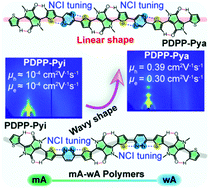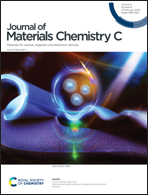All-acceptor polymers with noncovalent interactions for efficient ambipolar transistors†
Abstract
Exciting progress has been made recently regarding organic field-effect transistors (OFETs) owing to significant efforts devoted to the material design of semiconducting conjugated small molecules and polymers. However, the development of ambipolar or n-type OFETs lags behind that of p-type devices. Here, we propose a new strategy for the design of ambipolar polymers based on acceptors (A) of diazines (pyridazine or pyrazine) in a “moderate A-weak A (mA-wA)” architecture by integrating intrachain noncovalent interactions to rationally engineer the electronic structure, molecular planarity and backbone curvature of the conjugated copolymers. Thus designed mA-wA polymers with intrachain N⋯S interactions exhibit both high-lying HOMO and low-lying LUMO energy levels for ambipolar charge transport and good planarity with a linear backbone for high and balanced hole and electron mobilities up to 0.39 and 0.30 cm2 V−1 s−1, respectively. Furthermore, the flexible OFETs fabricated on polyethylene terephthalate substrates show high mobilities of 0.26 and 0.32 cm2 V−1 s−1 for holes and electrons, respectively. This design strategy with the newly discovered diazine acceptors to invoke both mA-wA and NCI effects in conjugated polymers for backbone engineering may be applicable to other systems, representing an advanced concept for the construction of high-performance ambipolar polymers.



 Please wait while we load your content...
Please wait while we load your content...